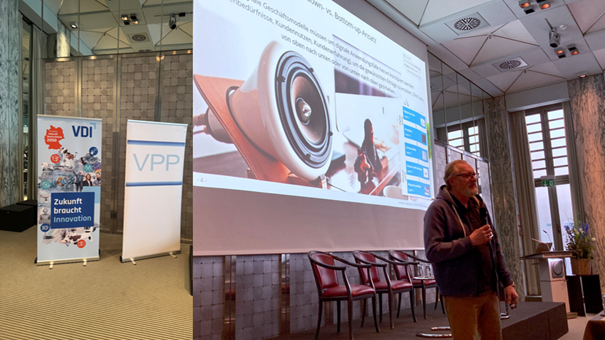Shaping the Future: Value-Driven Innovation and IP Strategies in the Digital Age
In an era where technological innovation is reshaping every industry at lightning speed, strategic intellectual property (IP) management has become a critical enabler of sustainable success. At the VDI/VPP seminar held on April 3, 2025, Professor Dr. Alexander J. Wurzer delivered a compelling presentation that dissected innovation methods and IP strategies tailored for the digital age. His insights, drawn from academic research, real-world applications, and patent analysis, offer a roadmap for how businesses can thrive by aligning innovation with value creation.
The Exponential Growth of Digital Innovation
The backdrop of Wurzer’s talk was the explosive growth of digital technologies and their patent filings since the early 2000s. From 2000 to 2018, the number of international patent families (IPFs) in Fourth Industrial Revolution (4IR) technologies such as artificial intelligence (AI), machine learning, quantum computing, and 5G/6G communications grew significantly faster than IPFs in all other fields. This surge underlines the strategic importance of digital transformation in shaping competitive industries.
These technologies are not just incremental upgrades—they are foundational shifts that redefine how businesses operate, engage customers, and generate value. Wurzer emphasized that in such a rapidly evolving ecosystem, traditional IP strategies fall short. What’s needed instead is a value-driven IP strategy: one that considers technological complexity, ecosystem interactions, and evolving customer expectations.
The Need for Value-Oriented IP Strategies
Citing research by Siemens executives Beat Weibel and Rudolf Freytag, Wurzer argued that digitalization necessitates a rethink of how intellectual property is perceived and managed. In traditional industries, IP often protects individual products or processes. In contrast, digital businesses operate within ecosystems where value is co-created across platforms, services, and user experiences.
This means that successful innovation today requires identifying and protecting entire use cases—not just individual inventions. These use cases must reflect customer needs, usage patterns, and the broader digital context. They become the basis for monetization models, competitive differentiation, and long-term value creation.
Top-Down vs. Bottom-Up Approaches to Use Case Protection
A key insight from Wurzer’s presentation was the distinction between top-down and bottom-up approaches to protecting digital use cases.
- Top-Down Approach:
This approach begins by thoroughly understanding customer needs, desires, and pain points. Based on these insights, companies design solutions specifically tailored to deliver maximum value and enhance user experience. Intellectual property is then strategically developed to protect the core value propositions embedded in these customer-centric solutions. - Bottom-Up Approach:
In this method, innovation starts with a new technological capability or breakthrough discovered through research or engineering. Companies then explore potential applications and markets where the technology could solve real problems or add value. The intellectual property strategy follows by securing the technological core, ensuring it can be flexibly applied across multiple domains.
Both approaches have merit, but in a complex, fast-moving digital world, the top-down strategy often leads to more robust and valuable IP portfolios because it ensures alignment with real market needs.
Case Studies: IP Strategies from SONOS and Spotify
To illustrate these concepts, Wurzer highlighted how companies like SONOS and Spotify have successfully protected their digital business models through strategic patenting.
- SONOS: Their core promise—wireless playback of digital audio in HiFi quality—is supported by patents like US8588949B2, which protects methods for adjusting volume levels in multi-zone systems. The IP here protects not just the hardware, but the user experience and system integration that define the brand’s value proposition.
- Spotify: Their business model hinges on seamless access to a vast catalogue of audio content. Patents like EP3298513B1 (for extracting sections from media objects) ensure Spotify’s innovations in personalized content delivery and reliable streaming remain protected.
These cases show how protecting “use cases” rather than isolated inventions can secure critical business functionalities in a digital marketplace.
Automotive Innovation and the IP Landscape
The automotive industry, undergoing its own digital revolution, was another focal point. Companies like Ford and Google are transforming cars into data-driven platforms. Innovations such as vehicle repossession via software (US2023055958A1) and content delivery in exchange for data (EP1958091B1) illustrate how traditional products are becoming part of digital ecosystems.
Google’s layered architecture—ranging from sensors (Layer 1) to digital services (Layer 5)—demonstrates the complexity of modern automotive solutions. Protecting such systems requires an IP strategy that spans hardware, connectivity, analytics, and service layers.
AI and Product Placement: Tencent and Mirriad
In the media and advertising space, AI is enabling new forms of content monetization. Wurzer presented Mirriad’s innovations in AI-based product placement as a case in point. Patents such as EP2304725B1 and US10362364B2 cover technologies for detecting and utilizing insertion zones within video content.
This capability allows advertisers to integrate products into existing videos dynamically, offering a scalable alternative to traditional advertising. The strategic value here lies in both the technology and the novel business model it enables—something IP must robustly protect.
Siemens Healthineers: Digital Ecosystem Integration
In healthcare, Siemens Healthineers exemplifies how digital technologies and IP strategies can converge to support advanced business models. Wurzer outlined two use cases:
- Transactional Business Models: As illustrated by EP3404436B1, where functional MRI data becomes part of a usage-based model.
- Pay-per-Use Systems: Protected by EP3066596B1, which supports on-demand medical device usage and data visualization.
These use cases highlight the shift from product sales to service-based revenue models—transformations enabled and safeguarded by a strategic approach to patents.
Best Practice Examples from IP Subject Matter Experts of the IP Business Academy
Daniel Holzner: White Spot Analysis
 As digital technologies become increasingly pervasive across industries, the competition for intellectual property rights intensifies, making it more difficult to identify truly novel, patentable ideas. The sheer volume of existing patents can create a landscape that feels saturated, especially in fast-moving fields like artificial intelligence, biotechnology, and connectivity. This environment poses a significant challenge to companies aiming to develop innovations that are both original and legally protectable.
As digital technologies become increasingly pervasive across industries, the competition for intellectual property rights intensifies, making it more difficult to identify truly novel, patentable ideas. The sheer volume of existing patents can create a landscape that feels saturated, especially in fast-moving fields like artificial intelligence, biotechnology, and connectivity. This environment poses a significant challenge to companies aiming to develop innovations that are both original and legally protectable.
To address this issue, Wurzer presented white spot analysis, by Daniel Holzner as a strategic tool for navigating the dense IP terrain. This method involves systematically analyzing the existing patent landscape to pinpoint areas—so-called “white spots”—where few or no patents currently exist. These gaps often reveal unmet needs or underexplored technologies, offering fertile ground for breakthrough innovations. By targeting these spaces, companies can not only avoid infringement risks but also carve out unique positions in the market, potentially securing a critical edge over competitors.
Here You find the digital IP lexicon 🔗𝗱𝗜𝗣𝗹𝗲𝘅 about white spot analysis by Daniel Holzner
Robert Klinski: Invention Harvesting
 Wurzer emphasized that invention harvesting by Robert Klinski is essential in today’s innovation-driven economy. Unlike reactive patent strategies that focus on protecting inventions after they are developed, invention harvesting is a forward-looking approach. It involves embedding intellectual property expertise early in the research and development process to actively identify ideas with patent potential as they emerge. This systematic integration helps organizations capture valuable innovations before they become widely known or replicated by competitors.
Wurzer emphasized that invention harvesting by Robert Klinski is essential in today’s innovation-driven economy. Unlike reactive patent strategies that focus on protecting inventions after they are developed, invention harvesting is a forward-looking approach. It involves embedding intellectual property expertise early in the research and development process to actively identify ideas with patent potential as they emerge. This systematic integration helps organizations capture valuable innovations before they become widely known or replicated by competitors.
Implementing invention harvesting successfully requires a cultural shift within organizations. R&D teams must work hand-in-hand with IP professionals, fostering a collaborative environment where legal insight supports technical creativity. This alignment ensures that promising developments are not overlooked and that patent protection is built into the innovation pipeline from the outset. Ultimately, this approach leads to stronger, more strategic IP portfolios that support long-term business goals and innovation leadership.
Here you find an explanation of invention harvesting on the 📑𝗜𝗣 𝗠𝗮𝗻𝗮𝗴𝗲𝗺𝗲𝗻𝘁 𝗟𝗲𝘁𝘁𝗲𝗿𝘀 by Robert Klinski
Nicos Raftis: Inventing Around, A Key IP Strategy
 In mature and saturated markets, discovering completely untouched areas for innovation—so-called “white spots”—is increasingly uncommon. As a result, companies must turn to the strategy of “inventing around” to stay competitive. This means designing alternative solutions that bypass existing patents while still addressing the same or similar problems. It requires a deep understanding of both the technical landscape and the legal boundaries set by prior patents.
In mature and saturated markets, discovering completely untouched areas for innovation—so-called “white spots”—is increasingly uncommon. As a result, companies must turn to the strategy of “inventing around” to stay competitive. This means designing alternative solutions that bypass existing patents while still addressing the same or similar problems. It requires a deep understanding of both the technical landscape and the legal boundaries set by prior patents.
“Inventing around” is more than a defensive tactic—it’s a driver of innovation. By encouraging teams to think differently and explore unconventional approaches, this strategy often leads to fresh, differentiated products and services. It also enables companies to build IP portfolios that are not only compliant but strategically positioned to offer market advantages. In essence, inventing around transforms limitations into opportunities, ensuring that businesses continue to innovate even within crowded and highly protected domains.
Here You find the digital IP lexicon 🔗𝗱𝗜𝗣𝗹𝗲𝘅 about systematic patent circumvention by Nicos Raftis
Sascha Kamhuber: The Role of Cross-Functional Integration
 To maximize the strategic value of intellectual property, Wurzer underscored the need to integrate IP strategy across multiple business functions—especially research and development, for example with the patent information tool, by Sascha Kamhuber. He highlighted the importance of equipping engineers with intuitive tools that allow them to conduct patent searches relevant to their materials or designs, even if they lack specialized IP training. For example, metallurgists working in steel development can access databases tailored to chemical and material properties, enabling them to identify potential patent conflicts early in the design phase. This proactive approach helps avoid costly legal issues later and ensures that innovation proceeds on solid ground.
To maximize the strategic value of intellectual property, Wurzer underscored the need to integrate IP strategy across multiple business functions—especially research and development, for example with the patent information tool, by Sascha Kamhuber. He highlighted the importance of equipping engineers with intuitive tools that allow them to conduct patent searches relevant to their materials or designs, even if they lack specialized IP training. For example, metallurgists working in steel development can access databases tailored to chemical and material properties, enabling them to identify potential patent conflicts early in the design phase. This proactive approach helps avoid costly legal issues later and ensures that innovation proceeds on solid ground.
Equally important is the collaboration between IP strategy and marketing or sales teams. As markets evolve and customer values increasingly emphasize sustainability, ethical sourcing, and corporate responsibility, these priorities must be reflected in the products a company develops—and in the patents that protect them. When marketing insights are directly aligned with the innovation pipeline, businesses can safeguard not only technological advancements but also the values that differentiate their offerings. This alignment ensures that IP portfolios are not just legally strong, but also market-relevant and responsive to emerging consumer trends.
Here you find an explanation of the integration of patent information in R&D on the 📑𝗜𝗣 𝗠𝗮𝗻𝗮𝗴𝗲𝗺𝗲𝗻𝘁 𝗟𝗲𝘁𝘁𝗲𝗿𝘀 by Sascha Kamhuber
Dr. Alihan Kaya: Integration of marketing and sales for patentable use cases
 Customers of technical products are becoming more and more aware of sustainability and social responsibility. In order to be able to protect the sustainability aspects relevant to customers, an integration of marketing and sales is also essential. This is the only way to develop an optimal IP position.
Customers of technical products are becoming more and more aware of sustainability and social responsibility. In order to be able to protect the sustainability aspects relevant to customers, an integration of marketing and sales is also essential. This is the only way to develop an optimal IP position.
Kaya advocated for a cross-functional approach where marketing, sales, and IP teams collaborate to identify and protect sustainability-driven innovations. This ensures that the unique aspects of sustainable products and services are adequately safeguarded through patents and other IP rights. Such integration not only enhances a company’s competitive edge but also reinforces its commitment to responsible innovation, resonating with consumers and stakeholders alike.
Here you find an explanation how to integrate IP know how in the early phases of use case development to ensure patentability 📑𝗜𝗣 𝗠𝗮𝗻𝗮𝗴𝗲𝗺𝗲𝗻𝘁 𝗟𝗲𝘁𝘁𝗲𝗿𝘀 by Dr. Alihan Kaya
Conclusion: Rethinking IP for the Digital Age
Wurzer’s presentation was a call to action for businesses, innovators, and IP professionals. In a world where digital transformation is the norm, success depends on aligning innovation with value—and protecting that value through strategically crafted IP portfolios.
Gone are the days when patents were merely legal shields. Today, they are strategic tools for market leadership, ecosystem participation, and customer engagement. By adopting a use-case-driven approach, integrating cross-functional insights, and continuously analyzing the IP landscape, companies can ensure that their innovations are not only protected but positioned to shape the future.



